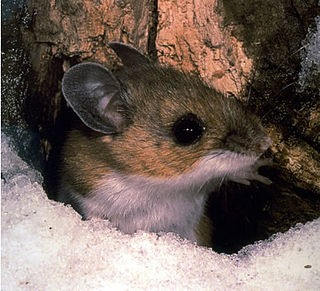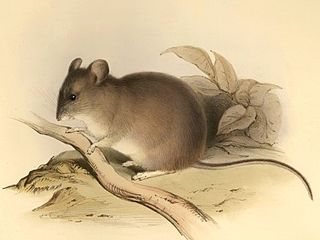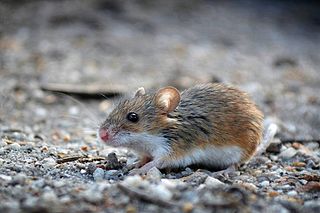
The Neotominae are a subfamily of the family Cricetidae. They consist of four tribes, 16 genera, and many species of New World rats and mice, predominantly found in North America. Among them are the well-known deer mice, white-footed mice, packrats, and grasshopper mice.
The cursor grass mouse, or cursorial akodont, is a sigmodontine rodent from South America.

The eastern pygmy possum is a diprotodont marsupial of south-eastern Australia. Occurring from southern Queensland to eastern South Australia and also Tasmania, it is found in a range of habitats, including rainforest, sclerophyll forest, woodland and heath.

Baiomys is the genus of New World pygmy mice. Together with Scotinomys, it forms the tribe Baiomyini. It currently contains two extant species:

The southern big-eared mouse, also known as the southern pericote, is a species of rodent in the family Cricetidae. It is found in Argentina and Chile, and is one of only two species in its genus. The type specimen was captured by Charles Darwin in 1834 along the Santa Cruz River in Argentina, during the voyage of HMS Beagle, and was subsequently described by George Robert Waterhouse.

The southern pygmy mouse is a species of rodent in the family Cricetidae. It is found in El Salvador, Guatemala, Honduras, Mexico, and Nicaragua.

Oligoryzomys longicaudatus, also known as the long-tailed colilargo or long-tailed pygmy rice rat, is a species of rodent in the genus Oligoryzomys of the family Cricetidae. It is found in the southern Andes of Chile and Argentina, with an outlying population in eastern Argentina. As a common species with a wide range and a stable population, the International Union for Conservation of Nature has rated this rodent as being of "least concern".
The Colombian rice rat, also known as the white-footed Handley's mouse is a species of rodent in the family Cricetidae occurring only in Colombia. It was previously included in Oryzomys, but closely resembles the dusky montane rat, and accordingly both species were placed in the new genus Handleyomys in 2002.

The Zacatecan deer mouse or southern rock mouse is a species of rodent in the family Cricetidae. It is found only in Mexico, and is not considered endangered.

The cactus mouse or cactus deermouse is a species of rodent in the family Cricetidae. It is a species of the genus Peromyscus, a closely related group of New World mice often called "deermice". They are native to desert areas of western North America.
Eva's desert mouse is a species of rodent in the genus Peromyscus of the family Cricetidae found only in the Baja California peninsula of Mexico.
The tawny deer mouse or marsh mouse is a species of rodent in the family Cricetidae. It is found only in Mexico.

The yellow-rumped leaf-eared mouse, otherwise known as the Patagonian leaf-eared mouse, is a species of rodent in the family Cricetidae and order Rodentia. It is the most widespread member of the genus.
The plains harvest mouse is a species of rodent in the family Cricetidae. It is found in northern Mexico and the central United States.

Bailey's pocket mouse is a species of rodent of the subfamily Perognathinae, family Heteromyidae. It is found in Baja California, Sinaloa and Sonora in Mexico and in California, Arizona and New Mexico in the United States.

The Baluchistan pygmy jerboa or dwarf three-toed jerboa, is a species of rodent in the family Dipodidae. It is the only species in the genus Salpingotulus. Adults average only 4.3 cm (1.7 in) in head and body length, with the tail averaging 8 cm (3.1 in). Adult females weigh 3.2 g (0.11 oz). It is currently considered to be endemic to Pakistan. In the 1999 Guinness Book of Records, it was listed as tied for the smallest rodent in the world with the northern pygmy mouse.

The northern grasshopper mouse is a North American carnivorous rodent of the family Cricetidae. It ranges over much of the western part of the continent, from southern Saskatchewan and central Washington to Tamaulipas in northeast Mexico.

Pterygodermatites is a genus of parasitic nematodes in the family Rictulariidae. Their life-cycle is complex. Species include:

The African pygmy mouse is one of the smallest rodents. It is widespread within sub-Saharan Africa, and is kept as a pet in other parts of the world. Like the common and widely introduced european house mouse, it is a member of the enormous superfamily Muroidea, which includes over 1000 different species. It forms a super- species complex with Mus musculoides.
Pterygodermatites peromysci is an intestinal parasitic nematode in the genus Pterygodermatites of the family Rictulariidae.














